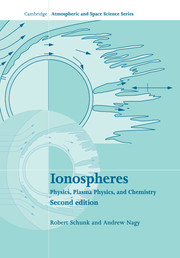Book contents
- Frontmatter
- Contents
- Chapter 1 Introduction
- Chapter 2 Space environment
- Chapter 3 Transport equations
- Chapter 4 Collisions
- Chapter 5 Simplified transport equations
- Chapter 6 Wave phenomena
- Chapter 7 Magnetohydrodynamic formulation
- Chapter 8 Chemical processes
- Chapter 9 Ionization and energy exchange processes
- Chapter 10 Neutral atmospheres
- Chapter 11 The terrestrial ionosphere at middle and low latitudes
- Chapter 12 The terrestrial ionosphere at high latitudes
- Chapter 13 Planetary ionospheres
- Chapter 14 Ionospheric measurement techniques
- Appendix A Physical constants and conversions
- Appendix B Vector relations and operators
- Appendix C Integrals and transformations
- Appendix D Functions and series expansions
- Appendix E Systems of units
- Appendix F Maxwell transfer equations
- Appendix G Collision models
- Appendix H Maxwell velocity distribution
- Appendix I Semilinear expressions for transport coefficients
- Appendix J Solar fluxes and relevant cross sections
- Appendix K Atmospheric models
- Appendix L Scalars, vectors, dyadics, and tensors
- Appendix M Radio wave spectrum
- Appendix N Simple derivation of continuity equation
- Appendix O Numerical solution for F region ionization
- Appendix P Monte Carlo methods
- Index
Chapter 5 - Simplified transport equations
Published online by Cambridge University Press: 22 January 2010
- Frontmatter
- Contents
- Chapter 1 Introduction
- Chapter 2 Space environment
- Chapter 3 Transport equations
- Chapter 4 Collisions
- Chapter 5 Simplified transport equations
- Chapter 6 Wave phenomena
- Chapter 7 Magnetohydrodynamic formulation
- Chapter 8 Chemical processes
- Chapter 9 Ionization and energy exchange processes
- Chapter 10 Neutral atmospheres
- Chapter 11 The terrestrial ionosphere at middle and low latitudes
- Chapter 12 The terrestrial ionosphere at high latitudes
- Chapter 13 Planetary ionospheres
- Chapter 14 Ionospheric measurement techniques
- Appendix A Physical constants and conversions
- Appendix B Vector relations and operators
- Appendix C Integrals and transformations
- Appendix D Functions and series expansions
- Appendix E Systems of units
- Appendix F Maxwell transfer equations
- Appendix G Collision models
- Appendix H Maxwell velocity distribution
- Appendix I Semilinear expressions for transport coefficients
- Appendix J Solar fluxes and relevant cross sections
- Appendix K Atmospheric models
- Appendix L Scalars, vectors, dyadics, and tensors
- Appendix M Radio wave spectrum
- Appendix N Simple derivation of continuity equation
- Appendix O Numerical solution for F region ionization
- Appendix P Monte Carlo methods
- Index
Summary
The 13-moment system of transport equations was introduced in Chapter 3 and several associated sets of collision terms were derived in Chapter 4. However, a rigorous application of the 13-moment system of equations for a multi-species plasma is rather difficult and it has been a common practice to use significantly simplified equation sets to study ionospheric behavior. The focus of this chapter is to describe, in some detail, the transport equations that are appropriate under different ionospheric conditions. The description includes a clear presentation of the major assumptions and approximations needed to derive the various simplified sets of equations so that potential users know the limited range of their applicability.
The equation sets discussed in this chapter are based on the assumption of collision dominance, for which the species velocity distribution functions are close to drifting Maxwellians. This assumption implies that the stress and heat flow terms in the 13-moment expression of the velocity distribution (3.49) are small. Simplified equations are derived for different levels of ionization, including weakly, partially, and fully ionized plasmas. A weakly ionized plasma is one in which Coulomb collisions can be neglected and only ion–neutral and electron–neutral collisions need to be considered. In a partially ionized plasma, collisions between ions, electrons, and neutrals have to be accounted for. Finally, in a fully ionized plasma, ion and electron collisions with neutrals are negligible. Note that in the last case, neutral particles can still be present, and in many fully ionized plasmas the neutrals are much more abundant than the charged particles. The plasma is fully ionized in the collisional sense because of the long-range nature of Coulomb interactions.
- Type
- Chapter
- Information
- IonospheresPhysics, Plasma Physics, and Chemistry, pp. 113 - 158Publisher: Cambridge University PressPrint publication year: 2009



